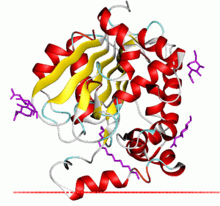Palmitoyl protein thioesterase
Palmitoyl protein thioesterases are enzymes (EC 3.1.2.22) that remove thioester-linked fatty acyl groups such as palmitate from modified cysteine residues in proteins or peptides during lysosomal degradation.
Neuronal ceroid lipofuscinoses (NCL) represent a group of encephalopathies that occur in 1 in 12,500 children. Mutations in the palmitoyl protein thioesterase gene causing infantile neuronal ceroid lipofuscinosis.[1] The most common mutation results in intracellular accumulation of the polypeptide and undetectable enzyme activity in the brain. Direct sequencing of cDNAs derived from brain RNA of INCL patients has shown a mis-sense transversion of A to T at nucleotide position 364, which results in substitution of Trp for Arg at position 122 in the protein - Arg 122 is immediately adjacent to a lipase consensus sequence that contains the putative active site Ser of PPT. The occurrence of this and two other independent mutations in the PPT gene strongly suggests that defects in this gene cause INCL.
Examples
Human proteins containing this domain include:
See also
References
- ↑ Hofmann SL, Vesa J, Hellsten E, Verkruyse LA, Camp LA, Rapola J, Santavuori P, Peltonen L (1995). "Mutations in the palmitoyl protein thioesterase gene causing infantile neuronal ceroid lipofuscinosis". Nature. 376 (6541): 584–587. doi:10.1038/376584a0. PMID 7637805.
External links
This article incorporates text from the public domain Pfam and InterPro IPR002472
|
|---|
|
| Activity | |
|---|
|
| Regulation | |
|---|
|
| Classification | |
|---|
|
| Types | |
|---|
